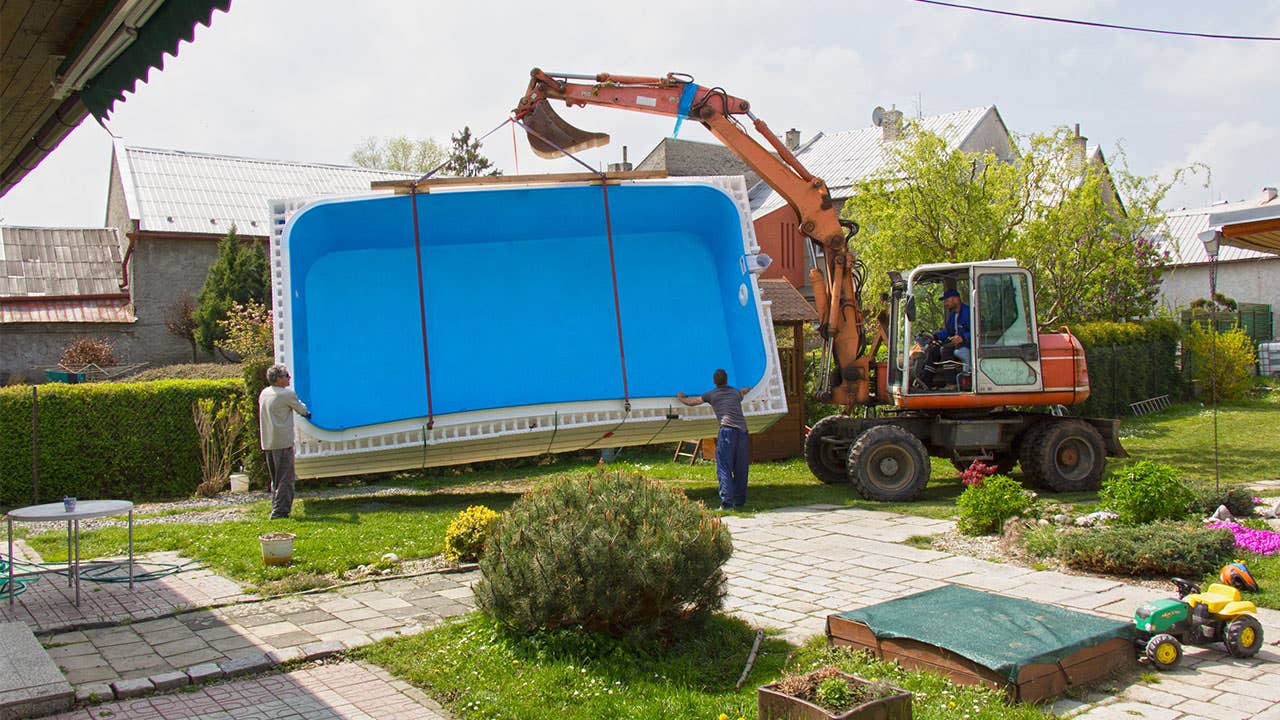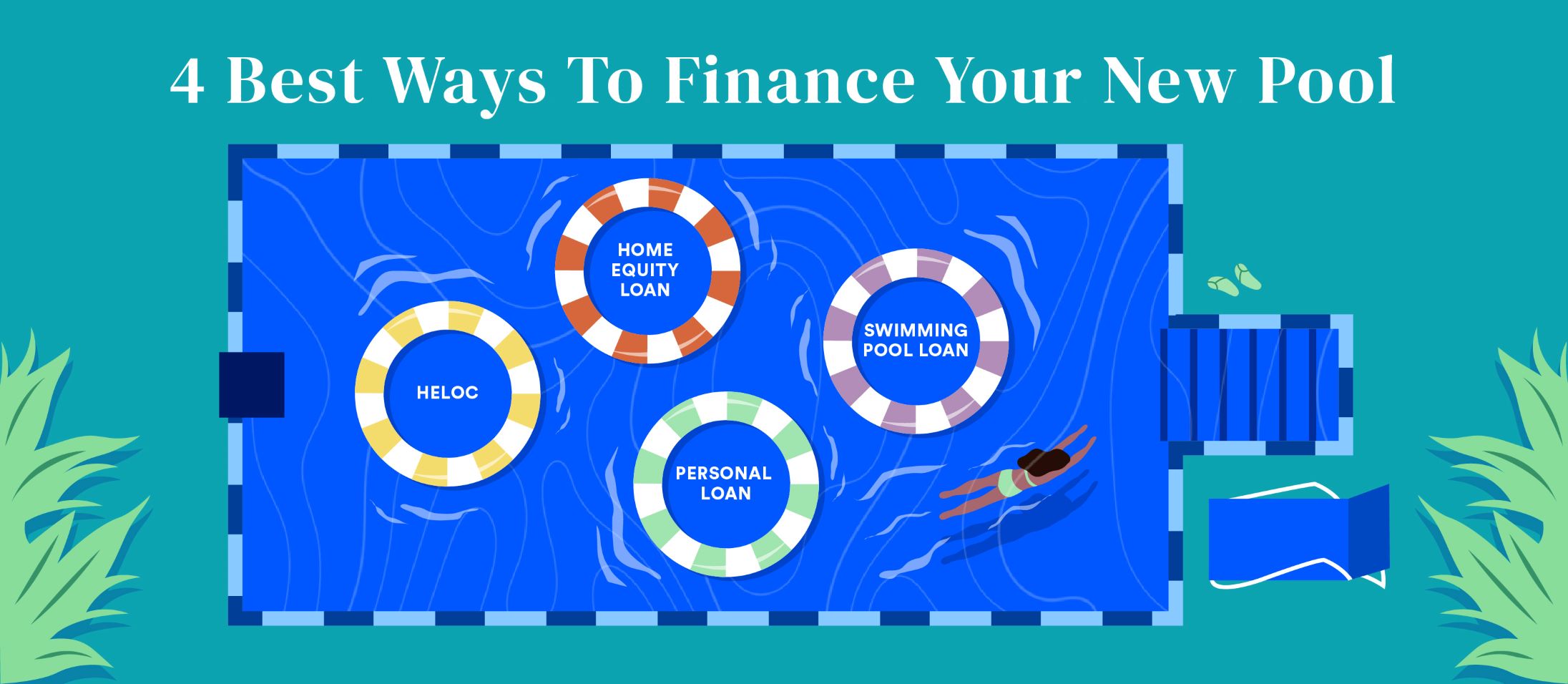What you need to know about financing a swimming pool

The Bankrate promise
At Bankrate we strive to help you make smarter financial decisions. While we adhere to strict , this post may contain references to products from our partners. Here's an explanation for .
Key takeaways
- Labor costs make up a large portion of the total price of installing a pool. If you were to install it yourself, you could save anywhere between $6,000 and $10,000.
- The total cost of a swimming pool will vary based on where you live, your backyard and local regulations.
- Personal loans are the most common way to finance a pool. Some companies offer in-house financing, which is often more expensive but can be more convenient.
Adding a swimming pool to your backyard can boost your property value and your enjoyment of your home. However, you shouldn’t dive into pool ownership without careful thought — and some money to spend.
Swimming pool costs vary depending on your location, yard, and pool dealer’s service packages. This means the price of a swimming pool project might be even higher than what your pool dealer originally quoted.
If saving tens of thousands of dollars to install a pool in your home isn’t feasible, financing swimming pool costs is an option. A swimming pool loan lets you pay off a pool build over time.
- The average cost for an above-ground pool can cost around $8,300, while the baseline for an in-ground pool can cost roughly $31,000.
- The annual cost of owning a pool could cost you anywhere between $3,000 to $6,000.
- There are 10.7 million swimming pools in the U.S., with 309,000 being public pools.
- In-ground and above-ground maintenance costs between $60 to $90 per hour.
- The average weekly cost of pool maintenance can cost anywhere between $20 to $50.
- Vinyl Liner pools are the least expensive in-ground pool option, costing anywhere from $40,000 to $60,000.
In-ground pool costs
There are a lot of variable costs associated with swimming pool installation, including the size of the pool, the material you choose, the type of water you use and how often maintenance is performed. You should do your own research and consult with a swimming pool contractor before making any decisions.
Here is a breakdown of the various costs associated with in-ground pool installation and maintenance.
Cost by material:
| Material | Installation cost |
|---|---|
| Fiberglass | $30,000-$85,000 |
| Concrete | $50,000-$120,000 |
| Vinyl | $25,000-$65,000 |
Cost by size:
| Size | Square feet | Average installed cost |
|---|---|---|
| Small | 10×20 | $16,000-$50,000 |
| Medium | 14×28 | $31,400-$98,000 |
| Large | 18×36 | $51,800-$162,000 |
Yearly maintenance cost:
| Yearly cost ranges | Average service cost |
|---|---|
| National Average Cost | $120 |
| Minimum Cost | $50 |
| Maximum Cost | $650 |
| Average Range | $80-$150 |
Source: HomeGuide
In addition to the cost of the pool itself, factor in the cost of renovations around the pool. This could include fencing, a deck and a cover for the off-season.
You should also factor in labor costs if you intend to hire someone to install the pool. The average labor costs for building a pool are between $8,000 and $30,000 depending on the specifications of the project and the materials used.
Installing the pool yourself could save you anywhere from $6,000 to $10,000. If you decide to install the pool yourself, make sure you have the tools and skills necessary and have all the required permits.
Once you have determined the overall cost of your pool installation, think about how you want to finance the project. Several financing options are available, including home equity loans and lines of credit, personal loans and swimming pool loans.
What is a pool loan, and how does it work?
Because installing a swimming pool is expensive, many homeowners turn to loans to finance the cost. Once you figure out how much money you’ll need for your new swimming pool, shop around and compare lenders to find a personal loan that works best for you.
Once you are approved for the loan, you’ll typically receive all of your loan funds upfront and will be given a set repayment timeline. Your income, credit history and credit score will be major factors in determining the interest rate and monthly payment of your loan.
4 ways to finance your new pool
Here are some of the best ways to finance your new swimming pool if you don’t have the cash to pay for it upfront.

Home equity loan
A home equity loan lets you borrow against the value of your home and use it as collateral, thus helping you secure a competitive interest rate. Home equity loans work like personal loans — they come with a fixed interest rate, a fixed repayment timeline and a fixed monthly payment that will never change.
Using your home as collateral does present some added risk. For example, your home will be subject to foreclosure if you stop making your home equity loan payment, which is not the case with personal loans. You can typically only borrow up to 85 percent of your home’s value minus any mortgage payments, so this option will only work for consumers with a lot of untapped property equity.
- Takeaway: Using a home equity loan for financing swimming pool projects offers low interest rates but puts your home at risk if you’re unable to pay the loan back.
- Who this is best for: This type of swimming pool loan is best for people who have significant home equity and are looking for fixed monthly payments.
HELOC
A home equity line of credit (HELOC) is similar to a home equity loan. With a HELOC, however, you get access to a line of credit that you can borrow against as needed — typically with a variable interest rate. Because your rate may go up and down due to rate fluctuations in the market and the amount you borrow isn’t set in stone, your payment can also change throughout the life of the loan.
As with a home equity loan, using a HELOC to finance your swimming pool does come with a few disadvantages. A HELOC also uses your home as collateral, meaning you risk foreclosure if you don’t make your payments. You are also subject to the same equity limits, meaning a HELOC is only a good option for borrowers with significant amounts of home equity.
- Takeaway: HELOCs offer more flexibility when financing swimming pool expenses, especially if your pool dealer doesn’t offer an all-inclusive package.
- Who this is best for: A HELOC is best for homeowners who have substantial equity and are looking for more flexibility with their monthly payments.
Personal loan
The most popular option among pool loans is the tried-and-true personal loan. A personal loan lets you borrow a lump sum at a fixed interest rate and with a fixed repayment period. This means you’ll be charged a regular monthly payment that will never change. Another benefit is that you’ll know exactly when you’ll become debt-free.
Personal loans are unsecured, meaning you don’t have to put your home down as collateral to get approved. If you have very good or excellent credit — or any FICO score over 740 — you may even be able to qualify for a pool loan with a fixed interest rate as low as 5 percent. Personal loans also often come with low or no fees, making them an inexpensive option compared to other financing options.
- Takeaway: Personal loans allow for financing swimming pools at a pre-set loan amount, and it’s a loan option that doesn’t put your home on the line if you default.
- Who this is best for: A personal loan is a great option for someone with good credit but not a lot of equity in their home.
Swimming pool loan through the dealer
Another option to finance your swimming pool may be a loan through the dealer you use to purchase it. If you do opt for dealer financing, carefully read the terms you’re agreeing to, and be prepared to pay higher rates. Still, if you’re not able to qualify for a personal loan or financing using your home’s equity, this may be the only option for financing your swimming pool.
- Takeaway: Financing swimming pool costs directly through your pool dealer can be a convenient but higher-cost option.
- Who this is best for: A swimming pool loan is the best option for someone who isn’t able to qualify for a home equity loan, HELOC or personal loan.
Other considerations when financing a swimming pool
Before you apply for pool financing, make sure you’re aware of the following details:
- Monthly payment: Speak with a few pool contractors to get a ballpark estimate of your final price. Once you have a few estimates, enter the information into a loan calculator to see your predicted monthly costs. If you want to pay your loan off quickly, you’ll need to pay more each month. If you plan to spread your payments out over a longer period of time, you’ll have a smaller monthly amount but will pay more in interest. smaller monthly amount.
- Repayment term: If you plan on selling your house in a few years, you’ll likely want to avoid a long loan term. You should also know that a home with a pool may be worth slightly more — but it may also appeal to a smaller group of buyers since not everyone wants a pool in their backyard.
- Debt consolidation: If you already have several credit cards and bills, you may want to consider eventually getting a debt consolidation loan so everything can be under one payment.
Pros and cons of installing a swimming pool

Pros
- Can increase the value of your home anywhere from 5 to 8 percent.
- Variety of size and shape options
- Fun and family-friendly summer activity
- Convenience/ability to have a staycation
- Enhances home aesthetic

Cons
- Requires regular maintenance
- Costly investment
- Liability concerns/Required safety measures
- Pools can attract animals and mosquitos
- Potential damage from weather
Frequently asked questions
As with most things, there’s not a single best loan to get for a pool. A personal loan could be a good bet if you need a large loan and you have a good credit score, while a home equity loan or HELOC could be better if you’re looking for the lowest interest rate possible and you don’t mind using your home as collateral.
-
Personal loans are available even for people whose credit scores need work (below 640). Just remember that the lower your credit score is, the higher your interest rate will be and the lower the loan amounts you’ll qualify for.
-
With a personal loan or home equity loan, you can generally target the length of time to pay back your loan. This will usually be between two and 10 years. The longer the loan, the lower each month’s payment will be but the more interest you’ll pay overall. With a HELOC, you’ll generally be able to draw from your credit line for 10 years, then pay back what you borrowed over 15 to 20 years.
Related Articles



How to make debt work for you: Build wealth with a personal loan
